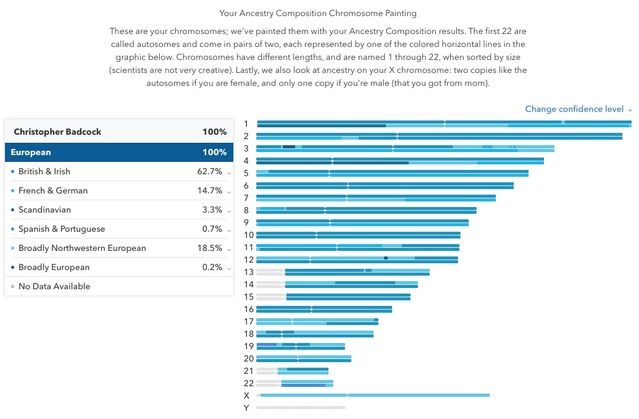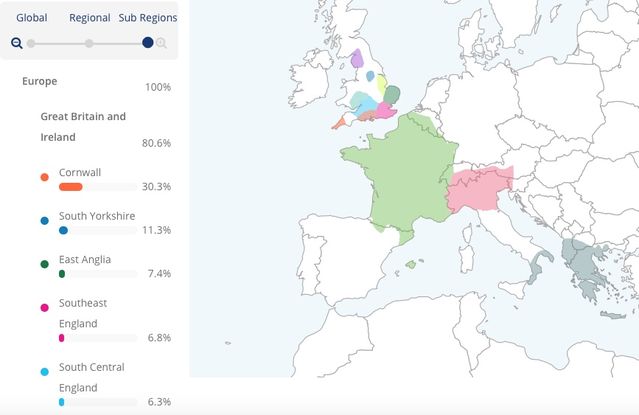Race and Ethnicity
A New, True View of Race and Ethnicity
Personal genomics gives objective insights into ethnic origins.
Posted January 19, 2019
According to the diametric model of cognition, many of the most important things we can think about have a real part in the physical universe but also an imaginary part in the mind, and race/ethnicity is a crucial case. The real part is rooted in genetics and descent, and the imaginary part in cultural ideology and personal consciousness. Until recently, the real part was tiny and rested on little more than obvious racial/ethnic differences that people could see, anthropologists could measure, or doctors could diagnose. The imaginary part, by contrast, was overwhelming in every sense of the word, and based in racial, national, or tribal ideology, religion, or folklore.
The result was that alleged national identities such as “British” were dubious indeed, given that Great Britain embraces at least three distinct ethnic groups: the English, Welsh, and Scots (with some others, such as the Cornish and Manx, that you could add for good measure). But that did not stop millions sacrificing their lives in national wars or, at the very best, forming passionate self-identifications with their nationality.
Not surprisingly, the whole concept of race and ethnicity became very controversial. Indeed, it is yet another example of what I described in a previous post as a cognitive complex understood in the Freudian sense of complex: a confused tangle of the real and the imaginary which bedevils a person’s life and seemingly cannot be resolved.
But now personal genomics is changing all that. As Robert Plomin comments in his new book, Blueprint, reviewed in a recent post:
Genomics is here to stay. The internet has democratized information to such an extent that people will not tolerate paternalistic regulations that prevent them from learning about their own genomes. The genie is out of the bottle and, even if we tried, we cannot stuff it back.
As I argued in a previous post, what you could properly call genetic or genomic literacy is likely to be as important a factor in twenty-first century history, culture, and politics as basic literacy was at the time of the Reformation in Europe. Then the sacred text, accessible only to the Latin-literate clergy, was The Bible. But today it is the genome, up to now the prized possession of its own priestly class: scientists, medics, entrepreneurs, and their self-appointed mediators with the public: publicists, science journalists, and authors of popular science books.
And the problem is the same as with the Bible. Once people get their hands on their own genomic data, they immediately begin to notice that it does not always correspond to what the priests have told them. Contrary to what we are assured in a recent popular science book on genomics, the X chromosome is not “the second biggest of all human chromosomes.” In fact, it is the eighth largest if you are counting numbers of genes or DNA bases (below). And despite the same author’s claim that “There’s no such thing as a Jewish disease,” 23andMe screens for 16 disorders “relevant for Ashkenazi Jewish descent.” Nor is this untypical: quite a few popular science books on genetics and genomics which I would have liked to review here had to be ignored because of my rule of not wishing to publish posts about anything of which I could not speak well. Blueprint was a notable exception, if not the only one.
Plomin’s book, by contrast, got a trashing at the hands of the same official inquisitors, notably in Nature. But whatever the priestly class may say, Plomin is right, despite their anathematizations: personal genomics is changing everything, and most importantly in three crucial ways.
First, personal genomics cannot fail to teach people basic genetics—and furthermore in a personally relevant, direct way that will make the lesson much more memorable. Reading a genetics textbook about recombination, crossing-over, and linkage is not the same thing as seeing the results graphically represented in your own DNA (below). And although mitochondrial genes and their inheritance might seem recondite when you learn about it in a genetics text, seeing your own matriline plotted all the way back to Mitochondrial Eve makes it all real and relevant. Like it or not, many people will soon know their genetics and genomics better than some current writers of pop science do—especially when the lesson is taught by their personal risk of inheriting a genetic disorder.

Second, personal genomic profiles like mine (illustrated above) change the balance of real to imaginary where any individual’s identity is concerned decisively in favour of reality. As my personal data shows, I may be 100% European, but that figure is arrived at by summation of the different European parts, not by way of top-down imaginary European-ness. According to 23andMe, I personally am 62.7% British and Irish, and 14.7% French and German. Additionally, I am 3.3% Scandinavian, and 0.7% Spanish and Portuguese on one copy of chromosomes 19 and 22 at the 50% confidence level illustrated.

And although I would normally describe myself as "English," a DNA analysis by Living DNA above reveals that almost a third of my genes are Cornish, with none at all from the neighbouring county, Devon. Furthermore, 5.8% of my autosomal DNA is described as “Aegean,” which is not in the least surprising in view of the fact that we know that merchants from the Aegean were visiting Cornwall to buy tin from the mines there long before the Roman Invasion. If, as is likely, they also left traces of their DNA, then the Aegean factor in my genome is probably not unusual for someone with Cornish ancestry, and another fascinating tweak on my "Englishness."
A single racial or ethnic identity is in fact as fictitious as a single self if you take the real, genetic factor as seriously as the imaginary, mental one. The truth is that in the context of race/ethnicity the single self, however it is collectively or particularly presented, is an artefact of personal public-relations, and more the stuff of politics, publicity, or propaganda than it is of reality. Like it or not, each one of us is a temporary, bio-degradable vehicle for our genes, which came from predecessors that double with every generation you go back and which will be pulled apart in descendants in exactly the same way in every generation in which they go forward.
Indeed, thanks to the links to DNA relative-finder functions provided along with the test results, a person's real genome can now make them a part of a social group defined by DNA, not ideology, group-think, or political/tribal propaganda. Ancestry searches are already said to be second only to pornography on the internet, so it will not be surprising if DNA ancestry soon becomes a major factor in social networking.
A final point worth making is that, not only is personal genomics objective and personalized, but it is constantly advancing and inevitably will include more and more of a person’s traits—including, crucially for the inquisitors—behavioural and psychological factors. Indeed if the imprinted brain theory is to be believed, it will eventually embrace what you might call epigenetic relatedness, or at least, patterns of personal gene-expression along with inheritance. When this comes about, not just genetic and genomic, but true epigenetic literacy will become the norm, and each person’s DNA the real equivalent of the Bible.




